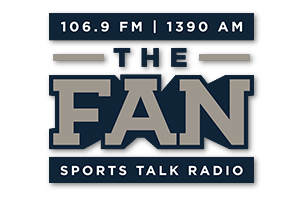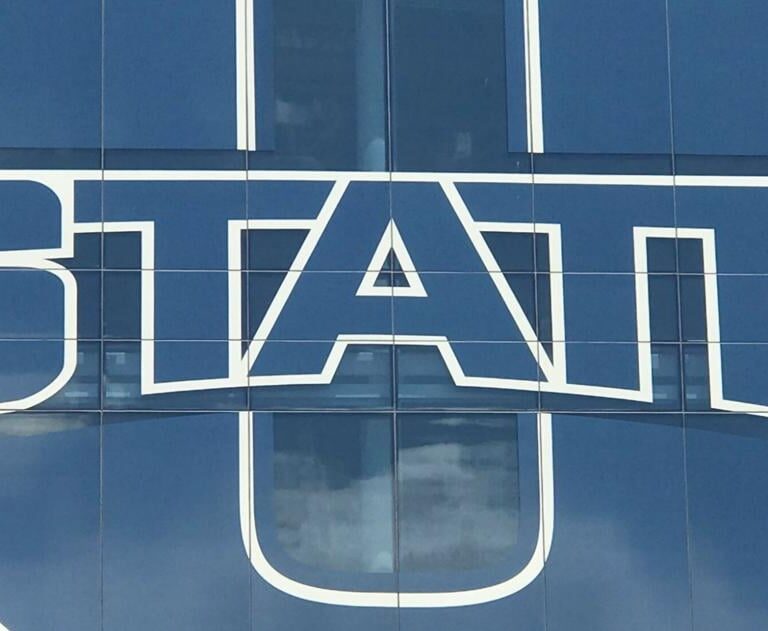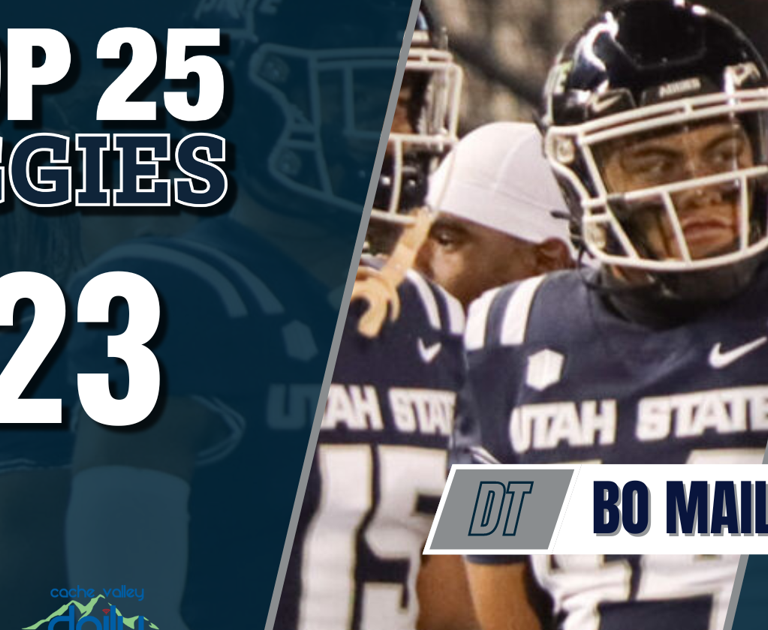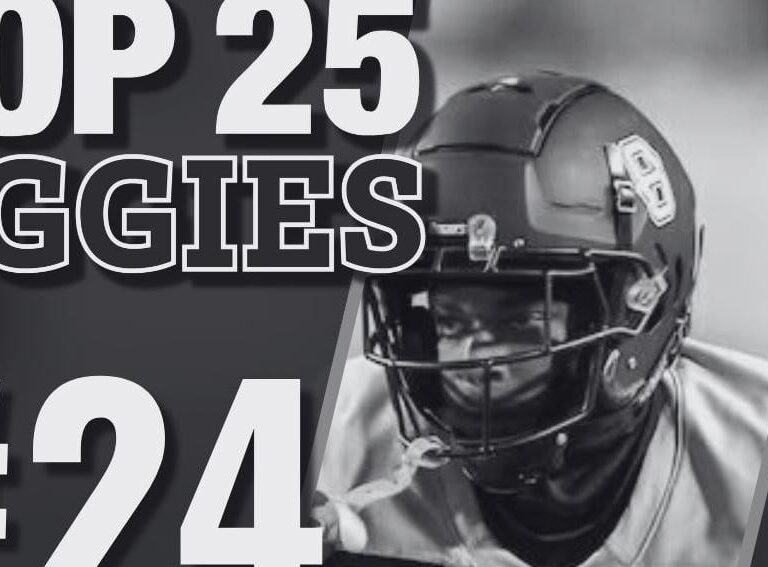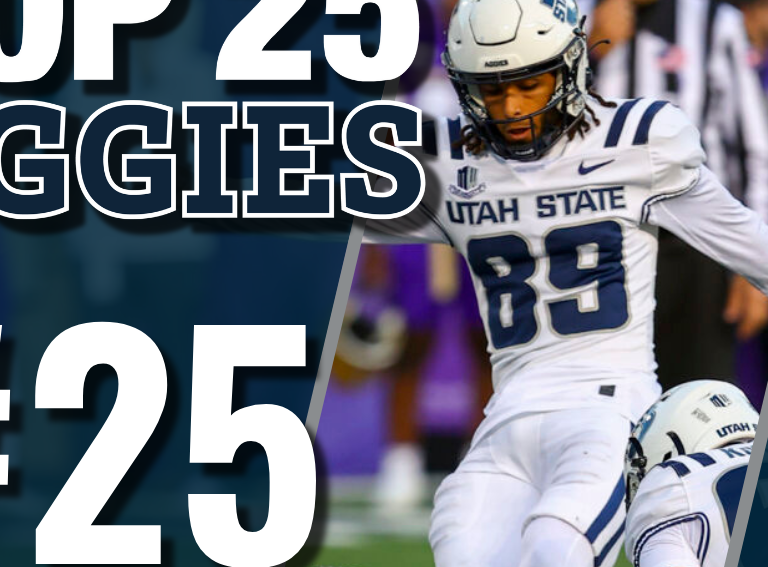Utah State defensive lineman, Poukesi Vakauta, lines up on defense during USU’s 34-24 loss to UNLV on September 24, 2022
This is the second article in a three-part series analyzing the three phases of the game for Utah State football for the upcoming 2023 season
Utah State’s defense took a massive hit in offseason attrition, losing starters and even backups left and right. Even after spring ball the Aggies weren’t safe from losing key players to the transfer portal. But with the window closed and presumably players will only be trickling in, if anything, we can take a look at how the defense stands and whether it can improve on the too-often porous defense of 2022.
Here’s a breakdown of each of the position groups on the defense, from the defensive line to linebackers and the secondary.
Defensive Line
Position Strength — Average
- Phil Steele MW Unit Ranking – 9th
- Athlon Sports MW Unit Ranking – 7th
The defensive line was hit as hard as any position group on this side of the ball, especially the defensive ends. Utah State’s three-headed pass rush of Daniel Grzesiak, Byron Vaughns and Patrick Joyner Jr. all left via the transfer portal. They took with them a combined 24.5 tackles for loss and 11.5 sacks with them, totals which amounted to 27 percent of USU’s TFLs last year and 41 percent of its sack production.
USU did its best to bring in quality replacements via the transfer portal and through recruiting the junior college ranks. Newcomers like Cian Slone, Harold Brooks and Blaine Spires were productive at their former clubs (Slone especially so with his 22 TFLs and 12 sacks at American River College last year). The Aggies also have up-and-coming prospects and returners like John Ward and Enoka Miagao who will look to fill the roles left by Grzesiak, Vaughns and Joyner.
The interior defensive line remains mostly in tact from last year, at least at the top of the depth chart. A good portion of the reserve defensive linemen left in search of greener pastures but Hale Motu’apuaka and Poukesi Vakauta both return. Motu’apuaka started each of the 12 games he appeared in last year while Vakauta started in six of 12.
Newcomers on the D-line are largely projected to fill in behind Motu’apuaka and Vakauta with some returners expected to vie to be in the rotation as well. Seni Tuiaki and Bo Maile return after some promising but limited snaps last year (Tuiaki was pressed into starting due to injuries but himself suffered a season-ending injury that cut his season short). As for newcomers, Clifton Mosley, Vaughn Mamea and Siaosi Lauhingoa are all making the jump from JuCo to Division I and bring some size with them.
That influx of size is something to watch out for with the interior defensive line. Last year the interior D-line rotation weighed an average of 278 pounds. Adding multiple 300-plus pound DTs like Mosley and Mamea along with Lauhingoa at 290 helps the Aggies get bigger with the average weight of the D-line potentially jumping by 10 pounds. Weight isn’t everything in the trenches, but it usually doesn’t hurt. It should give new defensive coordinator Joe Cauthen a solid foundation for an effective front line for his defense. USU’s heavy-set interior players may not rack up many stats, but a sign they’re performing their job could be an uptick in production from the linebackers and defensive ends who crash in on a clogged line of scrimmage to tackle runners and chase down quarterbacks.
The foundation could be there on the defensive line. But like much of this team it remains unproven and leaves room for uncertainty that this group will perform on gameday despite having some of the measurables past Aggies teams lacked.
Linebackers
Position Strength — Above Average
- Phil Steele MW Unit Ranking – 9th
- Athlon Sports MW Unit Ranking – 6th
There’s some real talent in the linebacker room with enough experience at the top to make this a solid crew for the Aggies. MJ Tafisi was highly productive last year — just under nine tackles per game — before an injury took him out of action toward the end of the season. The loss of AJ Vongphachanh to the transfer portal, who would have given the Aggies one of the best one-two punches at LB in the conference, does hurt but there’s enough depth to potentially replace his production.
Multiple young linebackers were pushed a bit early into high snap roles, guys like Max Alford and Omari Okeke. With that experience, combined with the development time the coaching staff were originally hoping to be able to give them before throwing to them to the wolves, could turn these players from mistake-prone freshmen into productive impact players.
Utah State also has several transfers from Power 5 programs. Gavin Barthiel and Logan Pili come in from Washington State and BYU, respectively. Both are younger (Barthiel is a sophomore, Pili a redshirt freshman) but have talent and good physical traits.
At the very least the Aggies will have a tackling machine in Tafisi which is always a plus. If the other young guns are able to utilize their respective talents to join Tafisi in being productive, this could easily be the best unit on the defense, perhaps even the team.
Defensive Backs
Position Strength — Average
- Phil Steele MWUnit Ranking – 10th
- Athlon Sports MW Unit Ranking – 8th
It’s a bit hard to be optimistic about the secondary since Utah State lost a lot of experience in this position group. They even had three defensive backs who committed to USU this offseason, spent spring ball with the team, and then left the program afterward. It’s been a rough road and if the Aggies are going to overcome it they’ll have to get it almost entirely from newcomers with a lack of Division I experience. But where there’s plenty of pessimism because of lost talent and a current lack of experience, there are several players in USU’s secondary who could be significant playmakers for the Aggies this season.
The headliner of said players is Ike Larsen, who has and will feature on a lot of preseason All-Mountain West teams. The 2022 honorable mention Freshman All-American was named to Athlon’s preseason First Team All-MW with Phil Steele placing him on the Second Team. It could be a big year for the sophomore Cache Valley native. He didn’t play a ton of snaps last year as a redshirt freshman, playing more on special teams before his impact plays forced the coaching staff into playing him more on defense. Only when that happened injuries began to limit his snaps. A fully healthy 2023 is one where Larsen could become a star.
Aside from Larsen, the Aggies do have veteran cornerback Michael Anyanwu who is among the most experienced players in terms of snaps played. Anthony Switzer, who will play a hybrid linebacker/safety role for the team (which kind of made it hard to place him when it comes to position groups), is also poised to live up to some of the hype he built up before an injury ended his 2022 season prematurely.
The Aggies bolstered the secondary with multiple Power 5 transfers, landing Simeon Harris out of Colorado and Al Ashford III from Wisconsin. Harris has a bit more experience, playing 322 defensive snaps as a true freshman last year (including four starts) while Ashford saw more time in special teams. But both were the kind of recruits coming out of high school that Utah State normally struggles to land so adding their talent should help. And boy do the Aggies need immediate help and talent with how much they lost in the defensive backfield.
On a similar note to the defensive line getting bulkier, the secondary is getting longer. Last year Ajani Carter was the only regular rotation corner that stood taller than 5-foot-10. This year, only Anyanwu and Xavion Steele are shorter than 5-10. Seven of the 10 CBs listed on the roster stand at least 6-foot. It’s an upgrade in length, but just like the defensive line’s bulk, those physical tools have to be used the right way.
Utah State’s secondary is more awash with talent than it has been in the past so it’s interesting that this would be the worst-ranked unit in the minds of national outlets like Phil Steele and Athlon. Some of that likely comes from how paper-thin the depth is along with the fact that this is yet another unproven group of players. So few snaps have been played by guys expected to take on massive roles with this team. And it’s a pretty darn young group, too. Larsen, Harris and Ashford will all be sophomores this upcoming season and three other members of the secondary are freshmen (two of them true freshmen). Early on there could be a lot of mistakes, though by the end of the year it could be quite the solid group of DBs.
